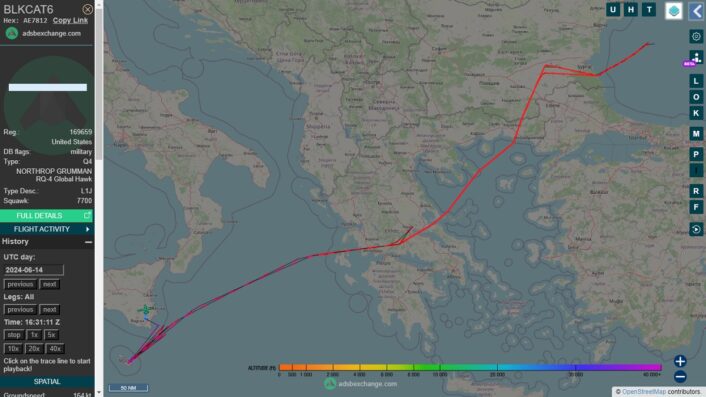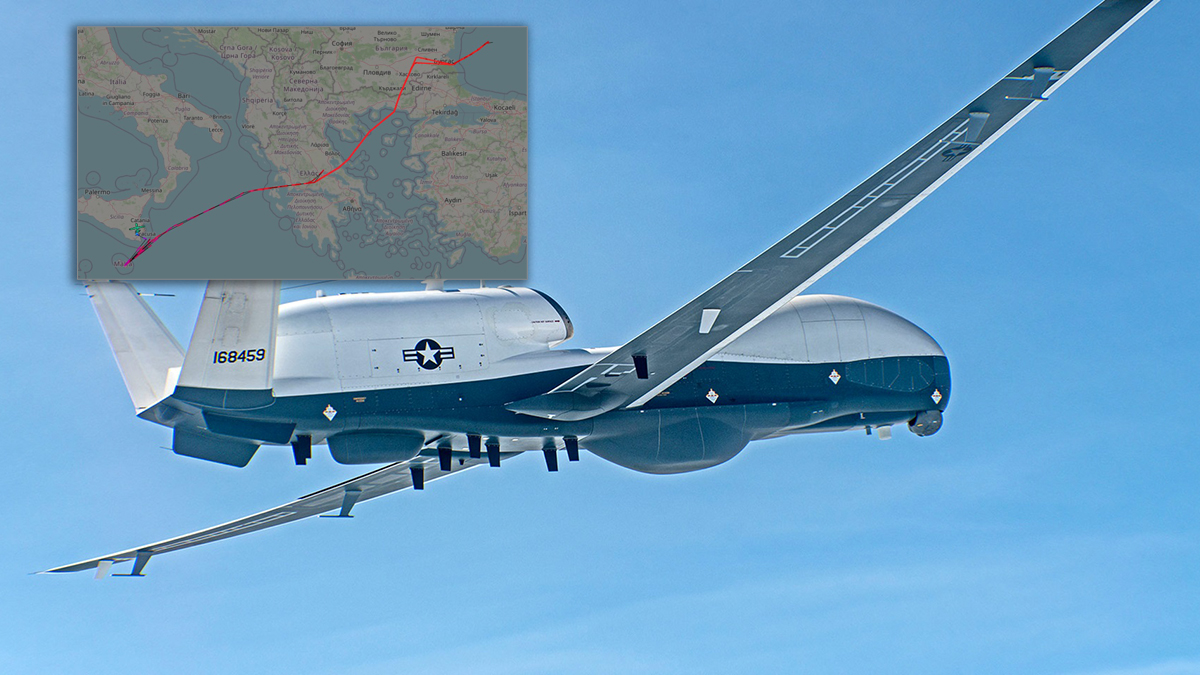The Tritons recently delivered to Naval Air Station Sigonella have been busy lately, flying missions off Libya and the Eastern Mediterranean Sea, with some rare trips to the Black Sea.
Naval Air Station Sigonella, Italy, received on Mar. 30, 2024, its first MQ-4C Triton Unmanned Aerial System, followed by a second one on Apr. 19. Since then, the two aircraft, assigned to Unmanned Patrol Squadron (VUP) 19 “Big Red,” have been flying regular missions over the Eastern Mediterranean Sea and off the coasts of Libya.
It wasn’t until recently that a Triton was noticed in flight also over the Black Sea during a mission on Jun. 14. While many considered it as the first trip of the new UAV to the area, upon further investigation we found out that this was the second mission to the Black Sea, after the first one on Apr. 29.
The aircraft involved in both flights appears to be the first MQ-4C delivered to Sigonella, serial 169659. The Apr. 29 mission was assigned the callsign TRITON19, while the Jun. 14 mission used BLKCAT6. The latter is the callsign routinely used also during the missions on the Mediterranean Sea.
First patrol for a US Navy MQ-4C Triton into the Black Sea. The newly formed unit at Sigonella has thus far concentrated its focus in the Mediterranean but has now joined the USAF in monitoring the Black Sea and activities in Crimea.
169659 as Blackcat-06#AE7812 pic.twitter.com/ogmvxOUMvJ
— MeNMyRC (@MeNMyRC1) June 14, 2024
Until now, the Black Sea was surveilled by the U.S. Air Force RQ-4Bs Global Hawk and NATO RQ-4Ds Phoenix, while the MQ-4C Triton focused on the Mediterranean Sea. The move makes sense as the MQ-4C is intended to augment the ability of the P-8 Poseidon to provide broad area, intelligence, surveillance, reconnaissance and targeting capabilities, and the Poseidon regularly patrols the Black Sea.
As often explained here at The Aviationist, U.S. Navy P-8As and RQ-4s operating out of Sigonella can be regularly tracked online by means of their ADS-B/Mode-S transponders, providing interesting insights into their missions over the Mediterranean and Black Sea. In fact, since the invasion of Crimea in 2014, the United States and NATO maintained a daily Intelligence, Surveillance and Reconnaissance presence over the Black Sea.

The MQ-4C Triton
The MQ-4C Triton is the Navy’s newest Intelligence, Surveillance, and Reconnaissance Maritime Patrol asset and augments the capabilities of the P-8 Poseidon maritime patrol aircraft. The aircraft is based upon the U.S. Air Force’s RQ-4B Global Hawk, while its sensors are based upon components of (or entire systems) already fielded in the DoD inventory, according to NAVAIR’s description.
Also known as Broad Area Maritime Surveillance (BAMS), the MQ-4C platform will complement the P-8A Poseidon within the Navy’s Maritime Patrol and Reconnaissance Force family of systems. Aircrew gather and process surveillance information utilizing data fusion tools that integrate sensor data from multiple aircraft into a comprehensive networked picture to further assist in building an accurate threat representation.
After assembling lessons learned from Triton’s initial deployment to Guam in 2020, the MQ-4C received significant updates including an upgraded sensor suite. These enhancements increase Triton’s ability to provide a persistent maritime intelligence, surveillance, reconnaissance and targeting (MISR-T) capability.
The MQ-4C is believed to be a sort of Block 20 and Block 30 Global Hawk hybrid, carrying Navy payload including an AN/ZPY-3 multi-function active-sensor (MFAS) radar system, that gives the Triton the ability to cover more than 2.7 million square miles in a single mission that can last as long as 24 hours at a time, at altitudes higher than 10 miles, with an operational range of 8,200 nautical miles.
Interestingly, while the Navy initially planned to procure 68 aircraft and 2 prototypes, it appears the Joint Requirements Oversight Council (JROC) re-assessed the MQ-4C Triton inventory requirement and scaled it down to 27 airframes, attributed to the program as 22 production, and 5 development (includes 1 test asset, 1 stricken UA and 25 fleet assets).
VUP-19 achieved initial operation capability in September 2023 (two years later than initially planned) during its new deployment to Andersen Air Force Base. As the only Navy unmanned patrol squadron, the unit will set a baseline for training Sailors and officers on the tactics, techniques and procedures of operating the MQ-4C Triton for future warfighting. The number of UAS assigned to each detachment has not been disclosed.













